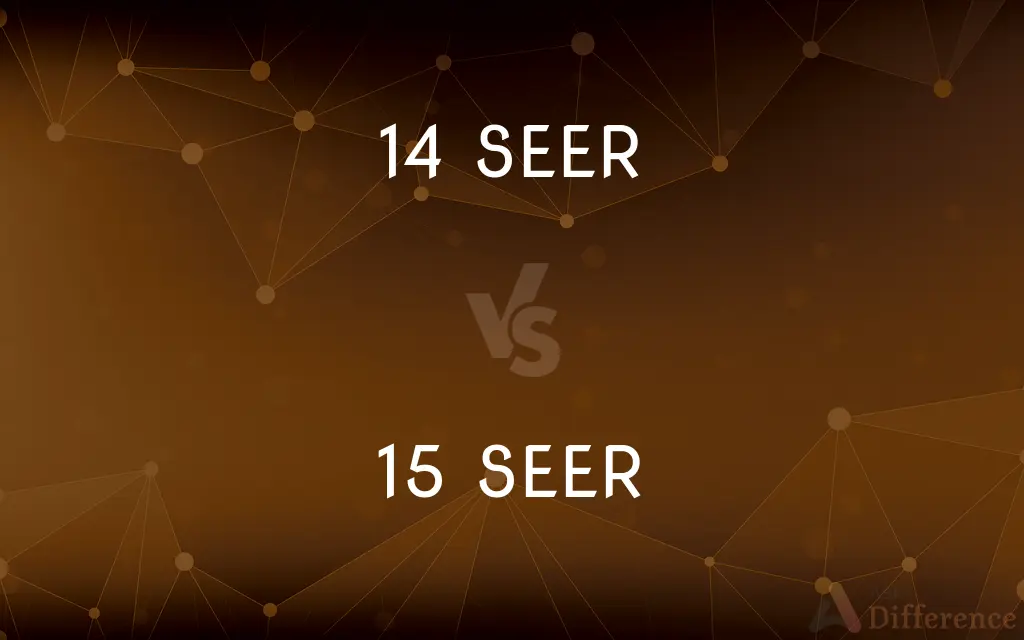14 SEER vs. 15 SEER — What's the Difference?
By Tayyaba Rehman — Published on January 23, 2024
SEER (Seasonal Energy Efficiency Ratio) is measure of an air conditioning system's efficiency. 14 SEER unit is less energy efficient than 15 SEER unit, which means 15 SEER unit is generally more cost-effective in long run due to lower energy consumption.

Difference Between 14 SEER and 15 SEER
Table of Contents
ADVERTISEMENT
Key Differences
14 SEER (Seasonal Energy Efficiency Ratio) units represent a standard level of efficiency for air conditioners and heat pumps. 15 SEER units, on the other hand, offer a higher level of efficiency, consuming less energy for the same cooling output. The higher the SEER rating, the more efficient the unit.
The efficiency difference between 14 SEER and 15 SEER may seem small, but it can result in noticeable differences in energy usage and cost over time. 15 SEER units are designed to use less energy, which can lead to lower electricity bills and less environmental impact.
When choosing between 14 SEER and 15 SEER, the initial cost is a significant factor. 15 SEER units typically have a higher upfront cost compared to 14 SEER units, but they offer savings in the long term due to reduced energy consumption.
In terms of environmental impact, 15 SEER units are a more eco-friendly option as they are more energy-efficient and reduce greenhouse gas emissions compared to 14 SEER units.
The choice between 14 SEER and 15 SEER can also be influenced by regional climate and usage patterns. In hotter climates or for households with high air conditioning usage, the higher efficiency of a 15 SEER unit can be more beneficial.
ADVERTISEMENT
Comparison Chart
Energy Efficiency
Standard efficiency
Higher efficiency
Energy Consumption
Higher compared to 15 SEER
Lower, more energy-efficient
Initial Cost
Generally lower
Generally higher
Long-term Savings
Less compared to 15 SEER
More due to lower energy costs
Environmental Impact
Higher energy use, more emissions
Lower energy use, fewer emissions
Compare with Definitions
14 SEER
More common in older or basic models.
My older AC model is a 14 SEER, which was standard at the time of purchase.
15 SEER
Environmentally friendlier option.
I chose a 15 SEER AC for its lower environmental impact.
14 SEER
Standard efficiency air conditioning unit.
I installed a 14 SEER AC unit for basic cooling needs.
15 SEER
More energy-efficient air conditioning unit.
I upgraded to a 15 SEER unit for better energy efficiency.
14 SEER
Higher energy consumption than 15 SEER.
The 14 SEER unit consumes more energy than newer models.
15 SEER
Lower energy bills than 14 SEER models.
My 15 SEER AC helps reduce my monthly electricity costs.
14 SEER
Lower initial cost but higher long-term costs.
Choosing a 14 SEER unit saved me money upfront.
15 SEER
Higher upfront cost, but more savings over time.
The 15 SEER unit was more expensive, but it'll save me money in the long run.
14 SEER
Suitable for moderate climates.
In our mild climate, a 14 SEER air conditioner is sufficient.
15 SEER
Ideal for hot climates and heavy usage.
In our hot region, a 15 SEER air conditioner is a must for efficiency.
Common Curiosities
Will a 15 SEER unit save me money?
Yes, a 15 SEER unit can save money on energy bills due to its higher efficiency.
What does SEER stand for?
SEER stands for Seasonal Energy Efficiency Ratio, measuring the efficiency of air conditioning units.
Is a 15 SEER much more efficient than a 14 SEER?
While the efficiency difference is not huge, a 15 SEER is more energy-efficient than a 14 SEER.
How is SEER rating calculated?
SEER rating is calculated by dividing the cooling output of an air conditioner over a typical cooling season by the energy it uses in Watt-Hours.
Should I upgrade from 14 SEER to 15 SEER?
Upgrading depends on your current unit’s age, your energy costs, and your environmental preferences.
Can I notice the difference in performance between 14 SEER and 15 SEER?
The performance difference may not be noticeable in everyday use, but the energy savings over time can be significant.
Is a higher SEER rating always better?
A higher SEER rating indicates more energy efficiency, which is generally better for long-term savings and environmental impact.
Does the SEER rating affect the cooling capacity?
SEER rating affects the energy efficiency, not the cooling capacity. Both 14 and 15 SEER units can have the same cooling capacity but different energy usages.
Do 14 SEER and 15 SEER units have the same maintenance requirements?
Maintenance requirements are generally similar, focusing on regular cleaning and inspections.
How much more does a 15 SEER unit cost compared to a 14 SEER?
The cost difference varies, but 15 SEER units are typically more expensive due to their higher efficiency technology.
What is the lifespan of a 15 SEER unit?
The lifespan of a 15 SEER unit is typically around 15-20 years, similar to other high-efficiency units, depending on maintenance and usage.
Can I use my existing ductwork with a new 15 SEER unit?
In most cases, existing ductwork can be used, but it's important to have it inspected to ensure it's in good condition and properly sized.
Are there any rebates for installing a 15 SEER unit?
Some regions offer rebates or incentives for installing higher-efficiency HVAC systems. It’s best to check local programs.
Share Your Discovery

Previous Comparison
Daily Harvest vs. Hello Fresh
Next Comparison
Articles of Confederation vs. Declaration of IndependenceAuthor Spotlight
Written by
Tayyaba RehmanTayyaba Rehman is a distinguished writer, currently serving as a primary contributor to askdifference.com. As a researcher in semantics and etymology, Tayyaba's passion for the complexity of languages and their distinctions has found a perfect home on the platform. Tayyaba delves into the intricacies of language, distinguishing between commonly confused words and phrases, thereby providing clarity for readers worldwide.













































